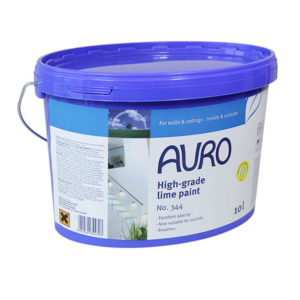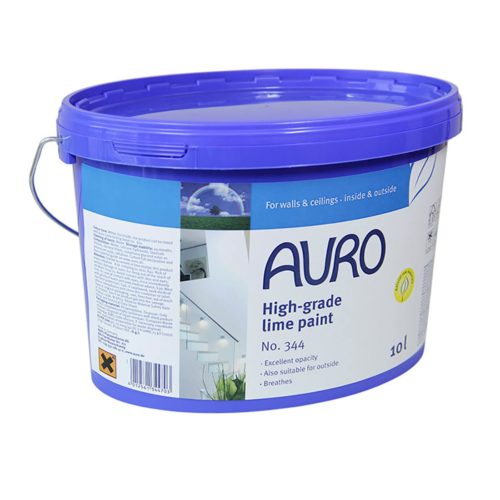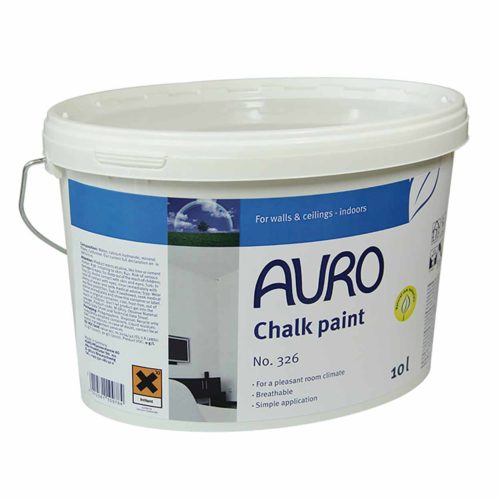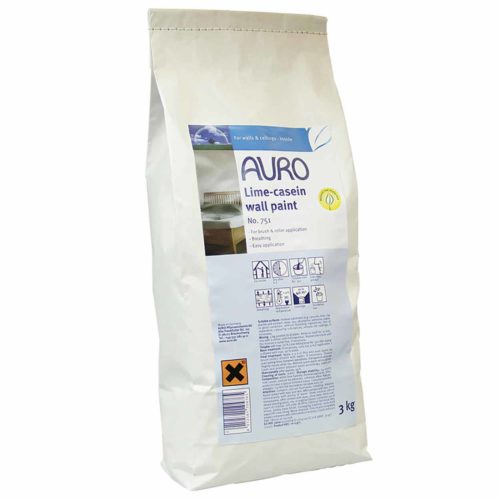Lime paint is a natural mineral paint made from slaked lime (also known as calcium hydroxide), water, and natural pigments.
Unlike conventional paints, it contains no synthetic binders or petrochemical additives. It's an environmentally friendly choice, valued for its breathability and ability to work in harmony with traditional building materials like lime plaster, stone, and brick.
This type of paint has been used to decorate homes for over 3,000 years. From ancient Roman temples to rural farmhouses, and it's still in use today. Made mainly from slaked lime and water, it offers a beautifully matt, breathable finish.

In an age of fume laden plastic and synthetic paints, lime paint is a literal breath of fresh air. Eco friendly, chemical free, and it even helps prevent mould thanks to its natural alkalinity.
Lime paint has come a long way since Roman times, modern production techniques mean it now offers a practical and durable finish that suits the way we live today. And if you prefer a more traditional finish similar to limewash? You can get that too!
See Also: How are lime paints made? | Difference between roman clay & limewash
Why Use Lime Paint?
One of the key benefits of lime paint is its breathability. It allows water vapour to pass through the painted surface, which helps to regulate moisture in buildings. This feature is particularly important in older and heritage properties with solid wall construction, where trapped moisture can lead to damp issues.
Lime based paint offers a uniquely beautiful finish, improves your indoor air quality, and is a sustainable, planet friendly choice.
Key Benefits of lime paint include:-
- Highly breathable paint – helps moisture escape rather than trapping it, ideal for solid wall construction, lime plaster, and heritage buildings.
- Natural anti mould properties – high alkalinity inhibits fungal and microbial growth
- Low or zero VOC – no petrochemicals, plastics, or harmful emissions
- Suitable for heritage buildings and porous surfaces – works in harmony with lime plaster, render, daub, and soft brick.
- Beautiful & unique texture – soft matt finish with tonal variation and a natural texture.
- Strengthens over time – lime cures through carbonation, becoming part of the wall structure
- Environmentally friendly – No synthetic binders, natural ingredients, low or no harmful emissions.
- Improves indoor air quality – lime paint will create a healthy atmosphere for your family and the planet.
These features make lime paint an ideal choice for those restoring period buildings or wanting to create healthy, breathable interior environments.
How Does Lime Paint Finish Look?
In terms of finish, lime paint creates a beautiful, soft matt effect with tonal variation and depth, especially when applied over textured surfaces.
A range of colours are available, meaning you can create the perfect colour scheme for your home.
Lime Paint Vs LimeWash
While both lime paint and limewash are made using slaked lime, they differ in composition, appearance, and application.
Traditional limewash is a much thinner mixture of lime and water, sometimes with added natural pigments. It soaks into porous surfaces like stone, brick, or lime plaster, creating a flat, chalky finish that can appear translucent when wet and may require frequent reapplication. Limewash is highly breathable but has limited durability on exterior surfaces exposed to weather.
Modern lime paints, by contrast, incorporate refined lime putty and offer better surface adhesion and durability. They are generally easier to apply consistently. Lime paints can also be used on a wider range of substrates, making them a more practical choice for both interior and exterior applications where a natural, breathable finish is desired.
Where Can Lime Paint be Used?
Lime paint is particularly suited for use on surfaces constructed with traditional building materials like stone, lime plaster, brick, and masonry. It can also be used on modern surfaces including plasterboard, concrete, and gypsum plaster.
All substrates should be dry, clean, and in good condition to ensure the lime paint can properly bond with the surface.
Where Not to Use Lime Paint
Lime paint isn't suitable for application over non absorbent or sealed surfaces like gloss paint, or plasticised wallpaper. These substrates will not allow the paint to bond. Damp, water ingress, or rising damp must all be treated and surfaces fully dried out before applying paint.
Exterior Use
When applied over suitable substrates such as lime render or masonry, lime paint can be used on exterior surfaces. Many owners of heritage homes and listed buildings use lime based exterior paints such as Graphenstone GCS to create the breathability old buildings need to remain healthy and damp free.
Lime paint provides an authentic finish on period properties, making it an excellent choice for those renovating or maintaining these types of buildings.
Does Lime Paint Prevent Mould?
Yes, lime paint has natural mould inhibiting properties due to its high alkalinity. The elevated pH level means the paint has natural fungicidal and algicidal properties, retarding mould and mildew growth. Lime based paint is a practical option for rooms with occasional moisture such as bathrooms or utility spaces.
However, lime paint is not a waterproofing product and will not solve underlying damp problems. It works best as part of a breathable system where walls can dry out naturally. For persistent damp or mould issues, it's important to identify and treat the root cause first.
Is Lime Paint Best for Use Over Lime Plaster?
Yes, lime paint is an excellent paint for lime plaster. Both materials are mineral based and share similar thermal and moisture movement characteristics. This compatibility helps prevent paint failure such as blistering or flaking and allows walls to "breathe" naturally.
Using lime paint on lime plaster helps maintain the integrity of traditional buildings, preserving the breathability and aesthetic appeal of historic interiors. When decorating over lime plaster, it's important that the plaster is fully cured (this may take several weeks) and free from dust or efflorescence before applying lime paint.
See Also: Gypsum Vs Lime Plaster
Lime Paint Application Guide
Due to its unique composition, lime paint needs a little more care during application that standard paints. Individual manufacturers recommendations will vary, but here's a general overview of how to use this paint type.
- Surface Preparation
Before painting, make sure the surface is:
- Dry and fully cured (mineral surfaces should be at least 28 days old)
- Firm and well-adhered
- Clean and free from dust, grease, or other impurities
- Even and smooth, as lime paint shows up surface flaws
Do not apply lime paint to surfaces that are in constant contact with water.
- Before You Start
- Protect anything not being painted, like glass or woodwork
- If a perfect finish is essential, do a small test area first
- Don't mix lime paint with other products
- How to Apply
- Use a brush or roller
- Apply 2 to 3 thin, even coats
- Work in small sections, starting with the edges
- Keep a "wet edge" to avoid visible joins
- Don't go back over drying areas
- Avoid applying too much paint at once, as this can cause fine cracks
- Drying and Curing Times
- Wait 2 to 4 hours between coats
- Surface dries in 24 hours
- Full hardness and durability develop over 30 days
- Don't scrub or wash the surface during the curing period
- Exterior Lime Paint Application
- Only apply when temperatures are between +5 °C and +40 °C
- Avoid painting in direct sunlight or on hot surfaces
- Surfaces must be dry and resistant to high alkalinity
- If rain is expected, delay painting until dry and protect for 4 days after application
- Use the same method as interior application: 2 to 3 even coats, taking care not to overload the brush or roller
How to Apply Lime Paint to Lime Plaster
Make sure the lime plaster is fully cured, which may take several weeks. Lightly dampen the surface before painting to support good absorption.
Stir the paint thoroughly, as it may settle in the tin. Apply 2–3 thin coats, allowing at least 24 hours between each. Use a brush or roller depending on the paint's formulation. For lime paints closer in composition to traditional limewash, a natural bristle brush and cross-hatch technique are recommended.
Avoid painting in direct sunlight or near heat sources, as rapid drying can lead to surface crazing.
See Also: How to apply limewash to walls
FAQ
Are Slaked Lime Paint & Lime Paint The Same?
Yes, slaked lime paint is another term for lime paint. It refers to the use of slaked lime (lime putty) as the main ingredient.
What is lime paint used for?
Lime paint is used on interior and exterior walls of buildings constructed with breathable, mineral-based materials such as lime plaster, render, stone, and brick. It is particularly suited to heritage properties and moisture-prone areas where wall breathability is essential.
Can you paint over lime paint?
Yes, you can repaint over lime paint with more lime paint, as long as the surface is clean and sound. If switching to a different type of paint, it is essential to check compatibility. Painting over lime paint or lime plaster with non breathable emulsions can trap moisture and lead to failure.
Does lime paint rub off?
When fully cured, lime paint is generally stable. However, it can be more fragile than modern emulsions. Traditional formulations closer in characteristic to limewash may rub off over time and will need reapplication. Check manufacturer's instructions for your chosen paint type.




